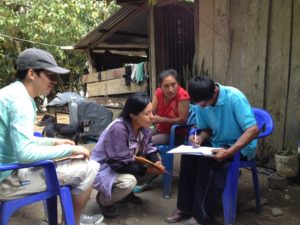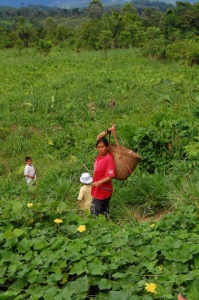
Working with smallholders in the valley of the rivers Apurimac, Ene and Montaro (VRAEM), a region of Peru, is a challenging task.
The region produces approximately 70 percent of the country’s illicit coca and is home to the last remnants of the Shining Path, an armed group that fought against the state between the 1980s and early 2000s.
But the area is now also of importance to cocoa production in the country as governmental agencies, cocoa buyers and development programs have been seeking to help expand and intensify cocoa production. Smallholders who had abandoned their farms after many years of conflict have now returned and are seeking alternatives to coca production.
Researchers from the World Agroforestry Centre (ICRAF) have supported one of the alternative initiatives, a cocoa value-chain development project sponsored by Lutheran World Relief and Sumaqao, a Peruvian cocoa buyer. Sumaqao has a long history of purchasing cocoa in the VRAEM and working with smallholders throughout Peru on fair trade and sustainable production. ICRAF was asked to evaluate how the project could have a larger impact on smallholders’ livelihoods and what steps should be taken to ensure that value-chain development is gender inclusive.
It was an opportunity to examine how gender inequalities — including access to services, participation in cooperatives and decision-making in households — hindered value-chain development, as well as the implications of gender relations for development strategies in the Peruvian Amazon, an area that has received little attention.
The ICRAF team conducted four structured interviews within each of the sampled households — aimed at reducing the potential of bias and inaccuracies — to explore gender-based differences in cocoa participation.
The first set of interviews included female and male household heads together. Following the interviews, the team discussed the answers and considered any discrepancies pertinent to the next interviews. The second set was conducted separately with each household’s primary male and female, covering their productive activities, perceptions of their involvement in cocoa production and the project. Finally, women were interviewed on their use of time the day before, as well as their interest in, and barriers to, their participation in the cocoa value chain. Key informant interviews were also carried out with non-governmental organizations, cocoa buyers and governmental officials to verify and clarify the findings.

The results revealed that cocoa intensification programs have greatly enhanced productivity and households’ incomes. Women played an important role in the transformation. They often carried out the same tasks as men, especially harvest and post-harvest activities, and were involved in making decisions on how the earnings from cocoa production were spent. However, women were excluded from making decisions about the marketing of cocoa and the purchase and sale of land and farm equipment.
Importantly, women’s increased participation in cocoa production had not been supported by a corresponding decrease in domestic work. About 30 percent of the interviewed women said that they were constrained by a lack of time to participate in training and cooperative meetings, even though they were interested in cocoa production. Women often felt uninformed about meetings, the provision of technical assistance and market conditions.
By looking at the impact of gender relations on intensification, relevant but nuanced and often neglected aspects of production and marketing that might determine the potential for value-chain development started to become more visible. One of them was the tension between women’s interest in participation in cocoa production and the time they had available for it. The gender dynamics around decision-making were also considered to be possibly related to their constraints in accessing information about markets, buyers and technical support.
Work to enhance cocoa production has had, and will likely continue to have, important impact on household incomes and wellbeing, suggesting that exploration should continue of gender dynamics, focusing on the gender responsiveness of value chains at various levels.
Recommendations for the development of a gender-inclusive value chain included sensitizing technicians to respond to the needs of women interested in cocoa production, testing diverse extension approaches that encouraged learning and exchange between men and women of different ages, as well as the use of alternative forms of communication technology that have a wider reach among different groups with varying literacy levels.
The results also suggested a need to move beyond the promotion of only cocoa to a “livelihoods approach”, which would include other economic activities that are also important for women and their household finances in the VRAEM.
Further, policies and programs promoting the intensification of cocoa production should also explore opportunities to transform gender relations that constrain women’s time, mobility and access to information instead of focusing on static or traditional gender roles that may already be changing because of male out-migration. The role of intersecting disadvantaging factors in creating barriers to deeper cocoa engagement also needs more examination. Further research will be needed to look at how factors like age and marital status influence these barriers at different stages of the value chain.
By Ana Maria Paez-Valencia and Trent Blare, originally published at ICRAF’s Agroforestry World.
This study forms part of the CGIAR Research Program on Forests, Trees and Agroforestry (FTA) and CGIAR Research Program on Policies, Institutions and Markets (PIM), which are supported by CGIAR Fund Donors.











